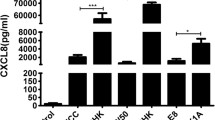Abstract
Gingival epithelial cells may form the first barriers of defense against oral bacteria in periodontal tissues. We stimulated human gingival epithelial cells (keratinocytes) in primary culture, the oral epithelial cell line KB and the colonic epithelial cell line SW620 with various bacterial cell-surface components in the presence or absence of soluble CD14 (sCD14). The SW620 produced interlukin-8 (IL-8) in an sCD14-dependent manner in response to lipopolysaccharide, lipoteichoic acid and peptidoglycan. However, the primary gingival epithelial cells and KB cells did not show enhanced production of IL-8 upon stimulation with these components even in the presence of serum. These human epithelial cells were devoid of membrane CD14, as determined by flow cytometry, and CD14 mRNA expression, as determined by reverse transcriptase-PCR. In contrast, gingival epithelial cells and KB cells expressed the mRNA expression for Toll-like receptor (TLR) 2, TLR4, MD2 and MyD88 to the similar extent to those observed in SW620 cells.
Similar content being viewed by others
Author information
Authors and Affiliations
Additional information
Electronic Publication
Rights and permissions
About this article
Cite this article
Uehara, A., Sugawara, S., Tamai, R. et al. Contrasting responses of human gingival and colonic epithelial cells to lipopolysaccharides, lipoteichoic acids and peptidoglycans in the presence of soluble CD14. Med Microbiol Immunol 189, 185–192 (2001). https://doi.org/10.1007/s004300100063
Received:
Published:
Issue Date:
DOI: https://doi.org/10.1007/s004300100063




